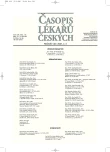Influence of Early Postnatal Nutrition in Preterm Infants on Their Anthropometric and Hormonal Characteristics at the Age of 10 Years
Authors:
H. Zamrazilová; V. Hainer; M. Černá 1; M. Kunešová; R. Braunerová; J. Štěpán 2; J. Nedvídková; M. Hill; J. Pařízková
Authors‘ workplace:
Endokrinologický ústav, Praha
; Ústav pro péči o matku a dítě, Praha
1; III. interní klinika 1. LF UK a VFN, Praha
2
Published in:
Čas. Lék. čes. 2007; 146: 278-283
Category:
Original Article
Overview
Backround.
A protective effect of breast feeding on the development of obesity has been clearly demonstrated. Several studies associated higher protein intake in postnatal period with the earlier “adiposity rebound” and the higher BMI in later life.
Methods and Results. Twenty eight girls born at 34th week of pregnancy (weight:
2.22±0.31 kg, length: 45.2±2.5 cm, BMI: 11.0±1.5 kg/m²), were subdivided in two groups differing in protein intake during the first postnatal month due to either breast feeding or formula feeding (113.5±18.7 g/month vs. 174.00±14.3 g/month; p<0.0001). Groups did not differ in average body weight, height and BMI at birth. Anthropometric and hormonal characteristics, body composition, energy and macronutrient intakes were determined at the age of 10 years in girls together with parental BMI. Association between the early postnatal nutrition and anthropometric and hormonal indexes at 10 years was evaluated. No significant differences between the groups in anthropometric and hormonal characteristics were found at 10 years except for IGF-1 which was significantly higher in the group with increased postnatal protein intake. Protein intake during the first postnatal month was not related to fat mass and leptin levels at 10 years. Protein intake during the first postnatal month significantly correlated with IGF-1 level, BMI and body circumferences at 10 years. Postnatal fat intake correlates with body circumferences and IGF-1 and also with sagital diameter and leptin at 10 years.
Conclusions.
Early postnatal nutrition could encode IGF-1 in later life and this way may be involved in body size programming. Factor analysis revealed IGF-1 as a link between the postnatal energy and macronutrient intake and anthropometric indices and leptin at the age of 10 years.
Key words:
postnatal protein intake, anthropometric indices, fat mass, leptin, IGF-1, preterm infants.
Labels
Addictology Allergology and clinical immunology Angiology Audiology Clinical biochemistry Dermatology & STDs Paediatric gastroenterology Paediatric surgery Paediatric cardiology Paediatric neurology Paediatric ENT Paediatric psychiatry Paediatric rheumatology Diabetology Pharmacy Vascular surgery Pain management Dental HygienistArticle was published in
Journal of Czech Physicians

Most read in this issue
- Neurosteroids and Their Function
- Relationships Between the „Eating Inventory“ Factors, Socioeconomic Status, Anthropometric Body Adiposity Indexes and Health Risks in Czech Population
- Obesity Based on Mutation of Genes Involved in Energy Balance
- Growth Hormone Treatment in the Institute of Endocrinology
